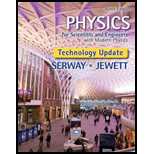
(a)
The total energy entering the system by heat per cycle.
(a)
Answer to Problem 76AP
The total energy entering the system by heat per cycle is
Explanation of Solution
Apply ideal gas equation at the point A.
Here,
Apply ideal gas equation at the point B.
Here,
Substitute
Apply ideal gas equation at the point C.
Here,
Substitute
Apply ideal gas equation at the point D.
Here,
Substitute
From figure P22.76, the curve
Write the expression for the heat change during process defined by curve
Here,
From figure P22.76, the curve
Write the expression for the heat change during process defined by curve
Here,
From figure P22.76, the curve
Write the expression for the heat change during process defined by curve
Here,
From figure P22.76, the curve
Write the expression for the heat change during process defined by curve
Here,
In this cycle heat is entering through process
Write the expression for the total heat entering the cycle.
Here,
This heat entering must be equal to heat absorbed from hot reservoir by the gas.
Here,
Conclusion:
The specific heat capacity at constant volume of the monoatomic gas is
Substitute
Substitute
Substitute
Therefore, the total energy entering the system by heat per cycle is
(b)
The total energy leaving the system by heat per cycle.
(b)
Answer to Problem 76AP
The total energy leaving the system by heat per cycle is
Explanation of Solution
In this cycle heat is leaving through processes
Write the expression for the heat leaving the system.
Here,
This heat leaving must be equal to heat expelled to cold reservoir by the gas.
Here,
Conclusion:
Substitute
Substitute
Substitute
Therefore, the total energy leaving of an engine operating in this cycle is
(c)
The efficiency of the engine operating in this cycle.
(c)
Answer to Problem 76AP
The efficiency of the engine operating in this cycle is
Explanation of Solution
Write the expression for the efficiency of the engine.
Here,
Substitute
Substitute
Conclusion:
Put the above two equations in equation (XVI) to find
Therefore, the efficiency of the engine operating in this cycle is
(d)
The comparison between actual efficiency of the engine and Carnot efficiency.
(d)
Answer to Problem 76AP
The Carnot efficiency of the engine is
Explanation of Solution
Write the expression for the Carnot efficiency.
Here,
Conclusion:
Substitute
Therefore, Carnot efficiency is
Want to see more full solutions like this?
Chapter 22 Solutions
Physics for Scientists and Engineers with Modern Physics, Technology Update
- Pls help asaparrow_forward3. If the force of gravity stopped acting on the planets in our solar system, what would happen? a) They would spiral slowly towards the sun. b) They would continue in straight lines tangent to their orbits. c) They would continue to orbit the sun. d) They would fly straight away from the sun. e) They would spiral slowly away from the sun. 4. 1 The free-body diagram of a wagon being pulled along a horizontal surface is best represented by A F N B C 0 Ꭰ FN E a) A b) B c) C app app The app 10 app d) e) ס ח D E 10 apparrow_forwardPls help ASAParrow_forward
- Pls help asaparrow_forwardPls help asaparrow_forwardThe acceleration of an object sliding along a frictionless ramp is inclined at an angle 0 is 9. a) g tano b) g cose c) g sino 10. d) g e) zero A 1.5 kg cart is pulled with a force of 7.3 N at an angle of 40° above the horizontal. If a kinetic friction force of 3.2 N acts against the motion, the cart's acceleration along the horizontal surface will be a) 5.0 m/s² b) 1.6 m/s² c) 2.4 m/s² 11. d) 1.0 m/s² e) 2.7 m/s² What is the net force acting on an object with a mass of 10 kg moving at a constant velocity of 10 m/s [North]? a) 100 N [North] b) 100 N [South] 10 N [North} d) 10 N [South] e) None of these.arrow_forward
- Modified True/False - indicate whether the sentence or statement is true or false. If the statement is false, correct the statement to make it true. 12. An object in uniform circular motion has a constant velocity while experiencing centripetal acceleration. 13. An object travelling in uniform circular motion experiences an outward centrifugal force that tends to pull the object out of the circular path. 14. An object with less inertia can resist changes in motion more than an object with more inertia. 15. For an object sliding on a horizontal surface with a horizontal applied force, the frictional force will always increase as the applied force increases.arrow_forwardPls help asaparrow_forwardAnswer the given question showing step by step by and all necessary working out.arrow_forward
 Principles of Physics: A Calculus-Based TextPhysicsISBN:9781133104261Author:Raymond A. Serway, John W. JewettPublisher:Cengage Learning
Principles of Physics: A Calculus-Based TextPhysicsISBN:9781133104261Author:Raymond A. Serway, John W. JewettPublisher:Cengage Learning Physics for Scientists and Engineers: Foundations...PhysicsISBN:9781133939146Author:Katz, Debora M.Publisher:Cengage Learning
Physics for Scientists and Engineers: Foundations...PhysicsISBN:9781133939146Author:Katz, Debora M.Publisher:Cengage Learning Physics for Scientists and Engineers with Modern ...PhysicsISBN:9781337553292Author:Raymond A. Serway, John W. JewettPublisher:Cengage Learning
Physics for Scientists and Engineers with Modern ...PhysicsISBN:9781337553292Author:Raymond A. Serway, John W. JewettPublisher:Cengage Learning Physics for Scientists and Engineers, Technology ...PhysicsISBN:9781305116399Author:Raymond A. Serway, John W. JewettPublisher:Cengage Learning
Physics for Scientists and Engineers, Technology ...PhysicsISBN:9781305116399Author:Raymond A. Serway, John W. JewettPublisher:Cengage Learning
 College PhysicsPhysicsISBN:9781938168000Author:Paul Peter Urone, Roger HinrichsPublisher:OpenStax College
College PhysicsPhysicsISBN:9781938168000Author:Paul Peter Urone, Roger HinrichsPublisher:OpenStax College





